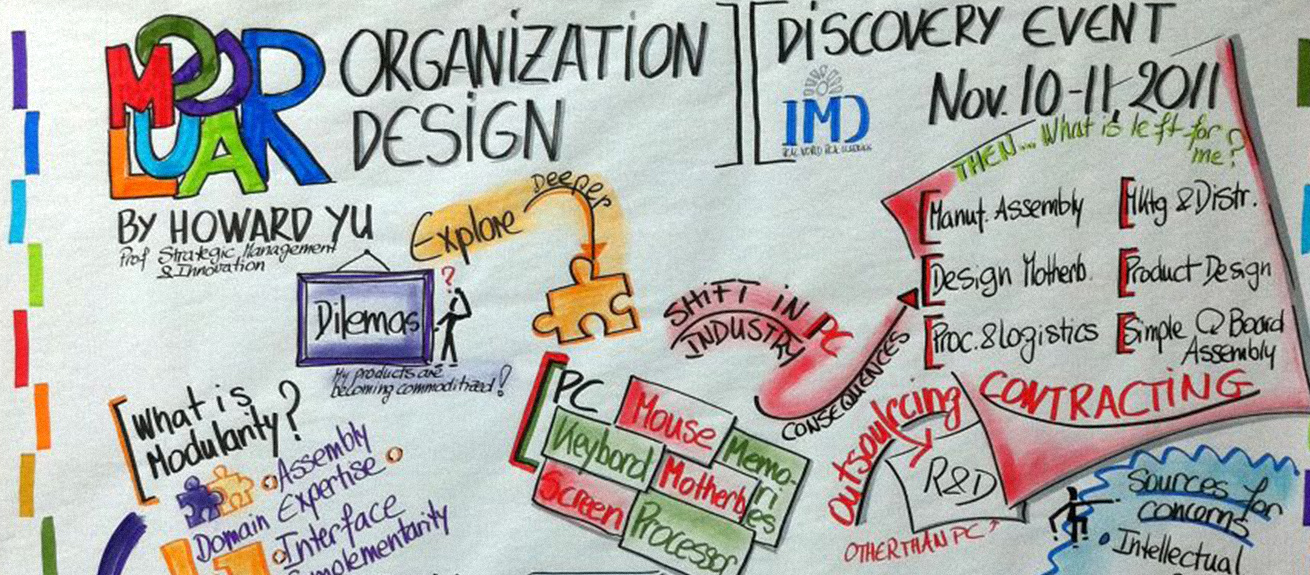More than 50 participants took part in an IMD Discovery Event to learn about the implications of the increasingly globalized economy on organizational design. Participants discovered the latest trends in organizational design and their pros and cons. They also learned from a panel of IMD alumni and an Indian entrepreneur about experiences in their organizations.
Organizational design is concerned with how companies are structured. Organizations as we now know them first emerged in the mid-1800s with the industrial revolution. Companies had clear boundaries and were self-contained, which was reflected in how they were managed. Materials were brought to the factory, transformed then shipped as final products to customers. These “closed boundary” organizations were typically organized around functions, divisions or in a matrix. From the late 1970s this format no longer functioned, so organizations moved to a “partially open boundaries” system. We started to see horizontal organizations such as Citibank’s paper factory, GE’s boundaryless corporation and Ford’s concurrent design.
Globalization and changing market dynamics have forced organizations to move to a more “open boundary” design in which they accept that others participate, to varying degrees, in manufacturing their products. The three models of open boundary organizations are: hollow, modular and virtual. Professors Narasimhan and Yu explored the pros and cons of the three models; and the guest speakers shared their experiences of managing the different organizational models.
Hollow organizations
Hollow organizations focus on their core competencies and outsource peripheral processes. For this to work, organizations must determine what core processes are critical to the mission, create a current or future competitive advantage and drive growth. They must also use the external market to cover the organization’s non-core processes, and align the suppliers’ incentives and the company’s strategic goals.
The advantages of hollow organizations include cost savings, with expenditures being less fixed and more variable, to allow companies to weather difficult economic times; using the latest technology on the market; and taking advantage of market forces to drive internal discipline.
Disadvantages include losing in-house capability and overall control; potentially losing the skills to innovate; and the risk of becoming dependent on suppliers. It is also challenging to write a contract that aligns the organization’s and the supplier’s incentives. The hollow design is usually used when prices are competitive and a market exists to supply the required internal processes. A good example of a hollow organization is Porsche, which outsourced its production to Valmet in Finland.
Indian entrepreneur, Venky Venkatesh Iyer, joined the session by conference call to discuss his company, Goli Vada Pav, which sells vegetable-like patties in a bun. The company evolved from an ethnic fast-food restaurant, consisting of a single 60 m2 shop, to a franchise brand with over 100 outlets in 26 cities. During its history, Goli Vada Pav faced many problems, which were all solved by outsourcing. For example, when it first started to scale up operations, the cooks made the patties. However, the quality was variable, and there was wastage and pilfering. Venky discussed the quality problems with a neighbor who supplied frozen potatoes for McDonald’s and who had spare capacity. The neighbor suggested using his plant to make standardized, frozen patties. Over time, Goli Vada Pav thus evolved into a hollow organizational design, and the only part that has not been outsourced is the brand and the proprietary spice mix used in the patties. The hollow organizational design allowed Goli Vada Pav the flexibility to provide ethnic fast food prepared in hygienic conditions in India and to achieve spectacular growth.
Modular organizations
Modular organizations order different parts from internal or external providers and assemble them into a product. For this to work, a company must first divide the product into manageable chunks; determine which parts could be manufactured more efficiently outside the organization; outsource these to appropriate suppliers; and finally assemble the different parts into the finished product. Designing interfaces to correctly link all of the different modules is essential in this structure. An example is outsourcing legal services, as in the case of HBO, which called upon the Indian legal outsourcing company, SDD Global, to defend its “Da Ali G” show from a libel case brought by “Jane Doe.” This option was considerably cheaper than using a US legal firm. Jane Doe eventually lost the case, but without the SDD Global option, HBO might have settled out of court.
Advantages of the modular design are that it takes advantage of competencies beyond the organization; is fast and efficient; and uses market forces to improve each piece. The disadvantages are that not all products can be divided into modules; getting the interface wrong can hamper assembly; and module producers that fall behind can hinder innovation of the final product. This organizational model is useful when it is possible to split the end product into modules and design interfaces to facilitate effective assembly.
The dangers of product commoditization
Professor Yu explained the dangers of product commoditization, an important risk in modular design, and shared strategies to overcome them. The consumer electronics, computer equipment and medical diagnostics industries have all experienced product commoditization. As standardized components became commoditized, companies reacted by differentiating their products but it was not long before these too were copied. Then they bundled products with services and sold the package as “a solution,” but soon competitors also began selling solutions.
The personal computer (PC) is a good example. PCs comprise many different components. The information exchanged between components is well defined and specific, and precise standards have allowed companies to specialize in manufacturing particular components. These manufacturers innovate in parallel; as long as they respect the standards, the final assembled products work perfectly. The obvious advantage of a modular product is thus the speed of improvement.
However, standardization also made it easy for other manufacturers to enter the industry, and some eventually became the dominant players, developing higher-level capabilities, while many Western PC firms have gradually “hollowed out” and essentially become technology companies without technologies. Products become commoditized because everyone is able to make them, and often at a lower cost because they do not have to invest in R&D.
But there is a way to fight this trend. Professor Yu illustrated how, using the example of Disney in China. Disney is well known for creating enduring characters and blockbuster animated films. But in China, DVD piracy eliminated any meaningful differentiation for Disney. The competitors’ pirated DVDs were exactly the same as the originals, but a fraction of the price and often released on the local market before the original because of the complicated and time-consuming clearing process of film screening by the Chinese government. So, not only did Disney’s Chinese competitors not have any R&D costs, but their speed to market was also better. How could Disney respond?
In 2008 Disney Publishing Worldwide launched the first Disney English learning center in Shanghai. The curriculum, developed in the US, is taught by native English-speaking trainers and targeted at children aged 2 to 10. The kids learn English using interactive technologies and timeless storytelling techniques in a theme park environment.
Disney discovered that parents who were unwilling to spend more than a few yuan on a movie (entertainment) would willingly spend considerable sums to invest in the best education for their children.1 So Disney reframed its product proposition in response to a specific consumer need: equipping kids from an early age to deal with the globalizing world in a fun environment. Interestingly, Disney in China was the only company with the brand, resources and position to create and deliver a compelling “product mix” that helped solve this problem. Three years into operation, Disney English has opened more than 30 centers around the country.
Importantly, Disney did not just come up with the right product, it also moved de facto into a new product category altogether. It could not have achieved anywhere near the same result by simply focusing on a new client group or negotiating with distributors. So, to counter product commoditization, executives must first rethink what problems their organizations can potentially solve for a specific audience, reintegrate the firm’s activities in a radically new way, and be prepared to take a completely different path.
Virtual organizations
Virtual organizations involve creating a company outside the organization to respond to an exceptional, and often temporary, market opportunity.
Temporary organizations are created with external partners and use technology to link people, assets and ideas. Each partner brings its own domain of excellence. Once the market opportunity evaporates, the virtual company either disbands or is absorbed into the larger organization. Examples are the Glad Wrap joint venture between Clorox and Procter & Gamble, which allowed P&G to compete with the Saran Wrap brand; and the Indian School of Business in Hyderabad, which was created by a partnership of Wharton, Kellogg and London Business School and classed 20th in the Financial Times Global MBA 2012 ranking.
Virtual companies allow organizations to respond quickly to the market, stretch to provide an extended product and/or service range, and leverage people, assets and ideas that fall outside their own boundaries. As with the other organizational designs, there are disadvantages.
Virtual organizations require intensive communication to avoid duplicating effort; a lack of trust among the various parties could decrease the benefits; and employees working in this type of environment may need additional motivation. This model is ideally suited to a partnership with another organization to respond to a fleeting market opportunity.
Summary
In order to respond to the ever-changing and globalized environment, companies are evolving their organizational design, which has mainly involved opening up and letting the outside in, but in different ways. We explored three open boundary models – hollow, modular and virtual. The examples demonstrate that the various models each have advantages and disadvantages. Companies can apply these designs to improve cost-effectiveness and take advantage of their partners’ innovation.
Discovery Events are exclusively available to members of IMD’s Corporate Learning Network. To find out more, go to www.imd.org/cln.

